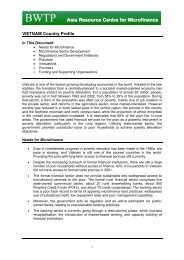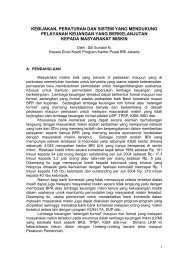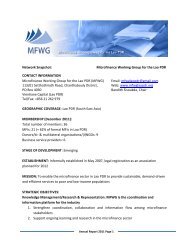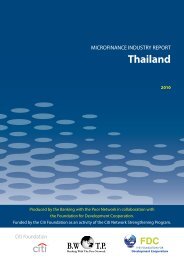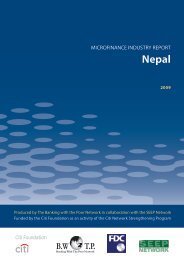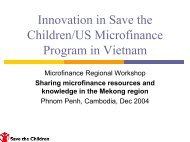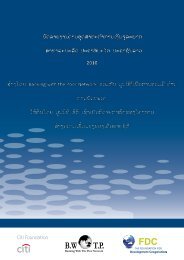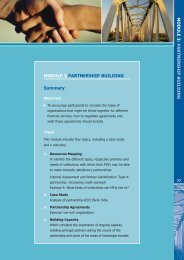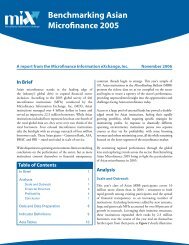microfinance industry report - Vietnam - Banking with the Poor Network
microfinance industry report - Vietnam - Banking with the Poor Network
microfinance industry report - Vietnam - Banking with the Poor Network
Create successful ePaper yourself
Turn your PDF publications into a flip-book with our unique Google optimized e-Paper software.
2.4 O<strong>the</strong>r Financial Services<br />
Remittances form an important part of Viet Nam’s<br />
financial landscape as inflows primarily from<br />
overseas <strong>Vietnam</strong>ese and laborers abroad. Private<br />
remittances are estimated to reach over $6 billion in<br />
2007, almost as much as Foreign Direct Investment<br />
inflows 30 . Remittances are generally channeled<br />
through <strong>the</strong> formal financial system and transfer<br />
services are available from most regulated financial<br />
service providers ei<strong>the</strong>r directly or through agent<br />
arrangements <strong>with</strong> specialized providers such as<br />
Western Union and MoneyGram.<br />
Social insurance and protection programs have<br />
been a focus area for <strong>the</strong> government over many<br />
years as well, and health insurance as well as pension<br />
schemes are available to low-income households.<br />
However, overall insurance penetration rate is lower<br />
in Viet Nam than elsewhere in <strong>the</strong> region <strong>with</strong> more<br />
than 90% of <strong>the</strong> population not having any formal<br />
insurance policy. 31 The private sector insurance<br />
<strong>industry</strong> has only recently begun expanding, and<br />
a series of policy and market changes have taken<br />
place over <strong>the</strong> past two years fostered by increased<br />
competition.<br />
Figure 7. Growth of insurance products<br />
Source: <strong>Vietnam</strong> Association of Insurers.<br />
Starting from a very low base, growth rates are<br />
impressive. By <strong>the</strong> end of 2006, <strong>the</strong>re were 37 firms<br />
of various legal form and scale operating in <strong>the</strong><br />
30 World Bank, Taking Stock, June 2008.<br />
31 Mark V.T. Saunders and Adrian Liu: Life Insurance 2/2006: “Viet<br />
Nam: A New Star in <strong>the</strong> East”.<br />
regulated life and non-life insurance, reinsurance,<br />
and insurance brokerage sectors. Of <strong>the</strong>se, three<br />
were fully state-owned (Bao Viet, Bao Minh, and<br />
Petro Viet Nam), 16 were joint stock companies, four<br />
were joint ventures and <strong>the</strong> remaining 14 were fully<br />
private 32<br />
The life insurance market started only in 1996 when<br />
<strong>the</strong> state-owned Bao Viet insurance monopoly was<br />
converted into <strong>the</strong> Viet Nam Insurance Corporation.<br />
Since 1980, Bao Viet has set up a nationwide network<br />
to provide services throughout <strong>the</strong> country.<br />
Bao Viet and Prudential each have around 40%<br />
market share by life premium income (2004), and <strong>the</strong><br />
top three companies (including Manulife) command<br />
around 90% of <strong>the</strong> market today. Combined life<br />
insurance products <strong>with</strong> savings and investment<br />
elements have accounted for a good part of <strong>the</strong><br />
growth, but <strong>with</strong> <strong>the</strong> competition from <strong>the</strong> banks<br />
and stock market heating up in 2007, this alternative<br />
to long-term savings instruments has come under<br />
pressure. The non-life insurance market (property<br />
and assets, fire and health) grew 25% year-on-year in<br />
2006, totaling sales of $189 million. Viet Nam has 15<br />
domestic companies selling non-life insurance, but<br />
Bao Viet (32% of total premium sales) and Bao Minh<br />
(24%) also dominate <strong>the</strong> non-life market.<br />
2.5 Access to Finance by <strong>the</strong><br />
Bottom of <strong>the</strong> Pyramid (BOP)<br />
There is consensus that <strong>the</strong> traditional market for<br />
<strong>microfinance</strong> services in Viet Nam constitutes 24<br />
million poor and low income people, or 5.4 million<br />
low-income households (LIHs) at <strong>the</strong> bottom of<br />
<strong>the</strong> economic pyramid (BOP). Among <strong>the</strong> poor,<br />
and in rural areas, VBSP, some PCFs and <strong>the</strong> semiformal<br />
<strong>microfinance</strong> organizations constitute <strong>the</strong><br />
main providers of credit, complemented to some<br />
extent by <strong>the</strong> directed credit channeled through<br />
VBARD and a vibrant, informal system of credit<br />
providers or traders, local shops, money lenders,<br />
and savings- and credit groups, of which many have<br />
developed in collaboration <strong>with</strong> socio-political ‘Mass<br />
Organizations’. Even <strong>with</strong> a relatively aggressive<br />
adjustment for double counting, it appears that <strong>the</strong>se<br />
32 World Bank: Viet Nam Development Report 2008 Social<br />
Protection, June 2008, from where <strong>the</strong> figure is also taken.<br />
<strong>Banking</strong> With The <strong>Poor</strong> <strong>Network</strong> 13<br />
<strong>Vietnam</strong>e_Report_FOR_PRINT.indd 13<br />
27/05/2009 7:46:01 PM



